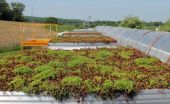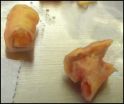(Press-News.org) Australian researchers are zeroing in on a promising new approach to killing off cancer cells in patients with leukemia.
In a study led by the South Australian Health and Medical Research Institute (SAHMRI) and the University of Adelaide's Centre for Personalised Cancer Medicine, researchers have found that cancer cells decide whether to live or die after a short period of intense exposure to targeted therapy, opposing the current requirement for continuous treatment.
The researchers say this study presents a new treatment strategy which will translate to a significant reduction in side effects for patients. The results have been published online ahead of print in the journal Leukemia.
"This discovery is paradigm shifting," says Professor Deborah White, Director, Cancer Research with SAHMRI and University of Adelaide professor. "Our findings are not just applicable to chronic myeloid leukemia (CML) therapy, but to all targeted cancer treatments.
"In our research, we're looking for methods that will result in the cancer cell killing itself. This would provide an improved treatment and reduce the risk of cancer relapse."
As a consequence of this finding, Professor White and colleagues identified a new target in resistant and persistent disease. They show that by blocking a common protein they can more effectively cause death in leukemia cells.
Professor White and her research team, including University of Adelaide PhD student Lisa Schafranek, have been investigating the role of a common protein known as STAT5.
"The activity of STAT5 appears to be a critical determinant of the decision for cancer cells to live or die," says Miss Schafranek, a Leukemia Foundation of Australia PhD scholar.
"Our research has found that by blocking STAT5 in conjunction with exposure to a regular anti-cancer treatment, we were able to more effectively target the leukemia cells. We now also better understand the timing required for the combined treatment to be effective."
INFORMATION:
The full paper can be found at the journal's website.
Media contact:
Professor Deborah White
Director, Cancer Research, South Australian Health and Medical Research Institute (SAHMRI)
Professor, School of Medicine; Centre for Personalised Cancer Medicine
The University of Adelaide
Phone: +61 8 8128 4302
deborah.white@sahmri.com
Game changer for leukemia therapy
2014-06-10
ELSE PRESS RELEASES FROM THIS DATE:
Women appear in only 5 percent of sports newsprint
2014-06-10
This news release is available in Spanish.
Women are the subject of news in sports papers in only 5.11% of the cases, sometimes alone (2.18%) and others accompanied by men (2.93%). On the other hand, men are the focus of this kind of information in 92.2% of the cases, according to a study presented recently by UC3M professor Clara Sainz de Baranda at the II International Conference on Gender and Communication. "The remaining 5% is neutral information, which is why, in these kinds of topics, like soccer balls, fields, field houses and goals, men appear more often ...
New teaching approach touted for engineering education
2014-06-10
WEST LAFAYETTE, Ind. – Purdue University researchers who developed a new approach to more effectively teach large numbers of engineering students are recommending that the approach be considered for adoption by universities globally.
The system, called the Purdue Mechanics Freeform Classroom, allows students to interact with each other and faculty online while accessing hundreds of instructional videos and animations. It was pioneered by Charles Krousgrill, a professor of mechanical engineering, and has been used for more than two years in two mechanical engineering core ...
Virginia Tech architect reveals 'green roofs' need not go to great depths to work
2014-06-10
Hot town, summer in the city — it's nothing new, but ways to handle the heat, humidity, and stormwater haven't changed much since the invention of the sewer system.
One solution offered by architectural researchers is known as a "green roof" — a roof covered in living, growing plants to soften the effects of heat, flooding, noise, and stormwater runoff.
Elizabeth J. Grant, an assistant professor of architecture and design at Virginia Tech, will present ways for architects to determine the most effective depths of green roofing for stormwater control on Thursday at the ...
Scientific breakthrough: International collaboration has sequence salmon genome
2014-06-10
Vancouver, BC - Today the International Cooperation to Sequence the Atlantic Salmon Genome (ICSASG) announced completion of a fully mapped and openly accessible salmon genome. This reference genome will provide crucial information to fish managers to improve the production and sustainability of aquaculture operations, and address challenges around conservation of wild stocks, preservation of at-risk fish populations and environmental sustainability. This breakthrough was announced at the International Conference on Integrative Salmonid Biology (ICISB) being held in Vancouver ...
MRI shows brain abnormalities in late preterm infants
2014-06-10
OAK BROOK, Ill. – Babies born 32 to 36 weeks into gestation may have smaller brains and other brain abnormalities that could lead to long-term developmental problems, according to a new study published online in the journal Radiology.
Much of the existing knowledge on preterm birth and brain development has been drawn from studies of individuals born very preterm, or less than 32 weeks into gestation at birth.
For the new study, researchers in Australia focused on moderate and late preterm (MLPT) babies —those born between 32 weeks, zero days, and 36 weeks, six days, ...
Bacteria help explain why stress, fear trigger heart attacks
2014-06-10
WASHINGTON, DC – June 10, 2014 - Scientists believe they have an explanation for the axiom that stress, emotional shock, or overexertion may trigger heart attacks in vulnerable people. Hormones released during these events appear to cause bacterial biofilms on arterial walls to disperse, allowing plaque deposits to rupture into the bloodstream, according to research published in published today in mBio®, the online open-access journal of the American Society for Microbiology.
"Our hypothesis fitted with the observation that heart attack and stroke often occur following ...
Fox Chase doctors urge caution over new analysis of Medicare payments
2014-06-10
PHILADELPHIA, PA (June 9, 2014)—There's much to learn from the recent release of unprecedented amounts of data from the nation's second largest health insurer, Medicare, but only if interpreted cautiously, write two doctors at Fox Chase Cancer Center in the June 9 online edition of the Annals of Internal Medicine.
In April, the Centers for Medicare and Medicaid Services (CMS) released the most detailed data in its history, related to $77 billion worth of physician billings to Medicare. In its analysis of the data, The New York Times showed that only a small percentage ...
Lifetime cancer risk from heart imaging low for most children; rises with complex tests
2014-06-09
DURHAM, N.C. -- Children with heart disease are exposed to low levels of radiation during X-rays, which do not significantly raise their lifetime cancer risk. However, children who undergo repeated complex imaging tests that deliver higher doses of radiation may have a slightly increased lifetime risk of cancer, according to researchers at Duke Medicine.
The findings, published June 9, 2014, in the American Heart Association journal Circulation, represent the largest study of cumulative radiation doses in children with heart disease and associated predictions of lifetime ...
'Jekyll and Hyde' protein linked to type 1 diabetes
2014-06-09
Researchers are a step closer to establishing the link between a protein with a split personality and type 1 diabetes.
New research, published today in the journal PNAS, shows how a protein, called GAD65, changes its shape when it turns itself on and off. Curiously, this characteristic may also link it to type 1 diabetes.
In the human brain, GAD65 performs an essential role: it makes 'neurotransmitters' - chemicals that pass messages between brain cells.
GAD65 is also found in the pancreas. Previous studies linked it to type 1 diabetes because the body makes antibodies ...
Mount Sinai researchers identify protein that keeps blood stem cells healthy as they age
2014-06-09
(New York – June 9, 2014) -- A protein may be the key to maintaining the health of aging blood stem cells, according to work by researchers at the Icahn School of Medicine at Mount Sinai recently published online in Stem Cell Reports. Human adults keep stem cell pools on hand in key tissues, including the blood. These stem cells can become replacement cells for those lost to wear and tear. But as the blood stem cells age, their ability to regenerate blood declines, potentially contributing to anemia and the risk of cancers like acute myeloid leukemia and immune deficiency. ...



